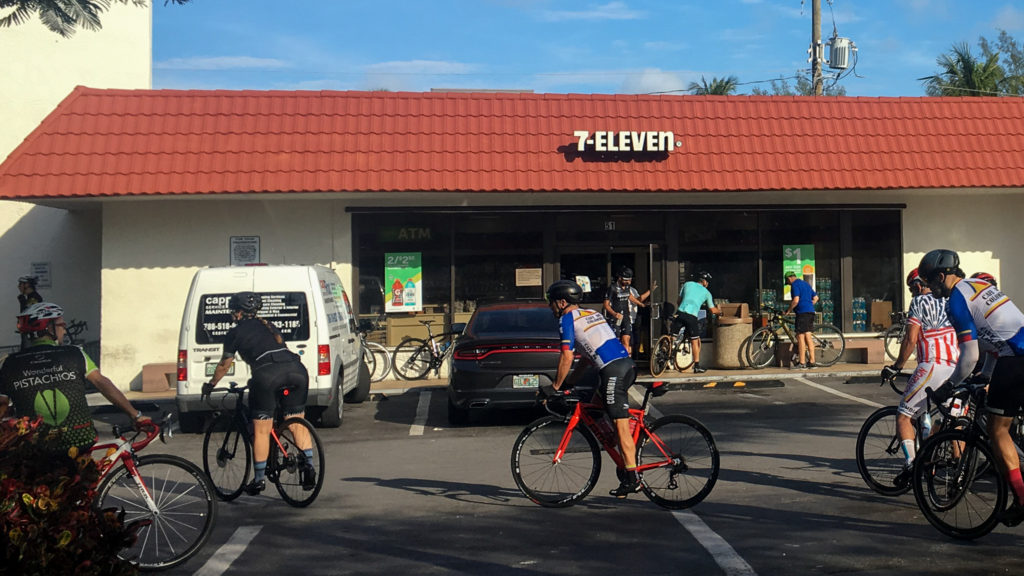Masculinity, Mental Health and Guns: Cyclists React to Shooting
Annali HaywardAugust 19, 2019

A group of cyclists gather at a favorite spot, the 7-Eleven on Key Biscayne, Aug. 17, 2019. Many said they were saddened and dismayed by the shooting. Aug. 17, 2019 (Key News/Annali Hayward)
Morning sunlight glances off the frames of thousand-dollar bikes clustered around Oasis Café. Tiny cups of Cuban coffee wordlessly pass between old friends. Nobody eats much. It’s a two-hour round trip for some, so cafécito and the breeze of the fans is all they need.
It’s a normal Saturday. Except for the topic of conversation.
“It’s senseless,” says Rudy Delatore, who cycles the route across the Rickenbacker causeway every week. Wednesday’s deadly shooting of cyclist Alexis Palencia did not so much shake the Miami cycling community as flummox it.
“Why would anyone riding on a bicycle along to Key Biscayne need to carry a gun?” sighs Tom, a member of another group who wished to use only one name.
The exact nature of the animosity between Kadel Piedrahita, who has now been charged with second-degree murder, and his victim remains unclear. It is evidenced, however, both in a livestream uploaded by Piedrahita before the shooting, and during the incident itself, captured on video and widely shared. Piedrahita calls out Palencia repeatedly, and it appears Palencia responds, leading to the scuffle. Officials have not confirmed who the gun belonged to.
“But this is typical of South Florida,” says Tom, who has been riding this route for 30 years. “Someone had a gun. If there had been no gun, this would have been a few pushes and everyone would have got back on their bikes and carried on.”
The peloton Palencia rode with is well-known among Miami cyclists. “They are kind of aggressive on the roads,” says Marcel Morlote, another of Delatore’s group, who estimates membership at around 50 mostly male riders on any given day.
“It’s common knowledge there’s a lot of road rage on Miami’s streets. Men want to be macho. But this is the first time we’ve ever had a shooting,” adds young cyclist Mark Herrera.
Carla Wilson, who has been riding here with Tom and husband Mark Wilson for over a decade, says her main concern is rider safety. “It’s been eight or nine years since a rider has been struck by a car,” she said. “Preventing that happening again is a bigger concern for the riding community.”
The reason so many pelotons cross the bridge to Key Biscayne is plain. “The water, the views. It’s the prettiest,” says Mark Wilson, a New Zealand native. “But it’s more about the people you ride with and the friendships you make.”
Cyclists describe a welcoming atmosphere in which strangers always stop to help each other out with flat tires, or to assist if anyone takes a tumble. “In my 40 years riding here I’ve never had any issue with anyone,” says Jeffrey Rosenbaum, a silver-haired Miami Beach resident and member of another peloton.
Do riders feel differently about their routes, the sport or its community after the event?
Overwhelmingly no.
“It was a personal thing between two individuals,” says Delatore.
Rosembaum agrees. “It’s an awful thing that happened, but for our community it is actually good that it was not a random act.”
Riders feel no need for increased police presence after the shooting. According to Morlote three agencies are usually present most days anyway – though not all are satisfied with their performance: echoing Wilson’s concerns for rider safety, Rosenbaum says police are doing such a bad job of controlling car speeds on the bridge that it is “almost negligent.”
“The problem,” says Rosenbaum’s teammate David Hartman, “is that someone had a gun that should not have.”
Hartman and others in his group realize easy access to guns for those with mental health problems is a major issue – though perhaps too big to tackle over a pit-stop cafécito.


